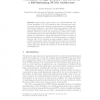Free Online Productivity Tools
i2Speak
i2Symbol
i2OCR
iTex2Img
iWeb2Print
iWeb2Shot
i2Type
iPdf2Split
iPdf2Merge
i2Bopomofo
i2Arabic
i2Style
i2Image
i2PDF
iLatex2Rtf
Sci2ools
EUROPAR
2001
Springer
2001
Springer
Performance of High-Accuracy PDE Solvers on a Self-Optimizing NUMA Architecture
High-accuracy PDE solvers use multi-dimensional fast Fourier transforms. The FFTs exhibits a static and structured memory access pattern which results in a large amount of communication. Performance analysis of a non-trivial kernel representing a PDE solution algorithm has been carried out on a Sun WildFire computer. Here, different architecture, system and programming models can be studied. The WildFire system uses self-optimization techniques such as data migration and replication to change the placement of data at runtime. If the data placement is not optimal, the initial performance is degraded. However, after a few iterations the page migration daemon is able to modify the placement of data. The performance is improved, and equals what is achieved if the data is optimally placed at the start of the execution using hand tuning. The speedup for the PDE solution kernel is surprisingly good.
| Added | 28 Jul 2010 |
| Updated | 28 Jul 2010 |
| Type | Conference |
| Year | 2001 |
| Where | EUROPAR |
| Authors | Sverker Holmgren, Dan Wallin |
Comments (0)

